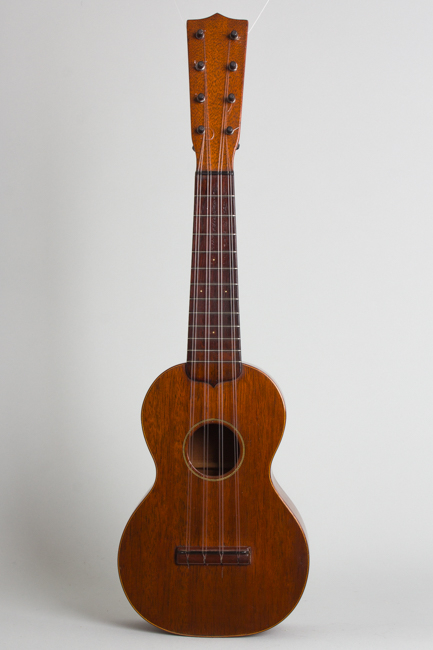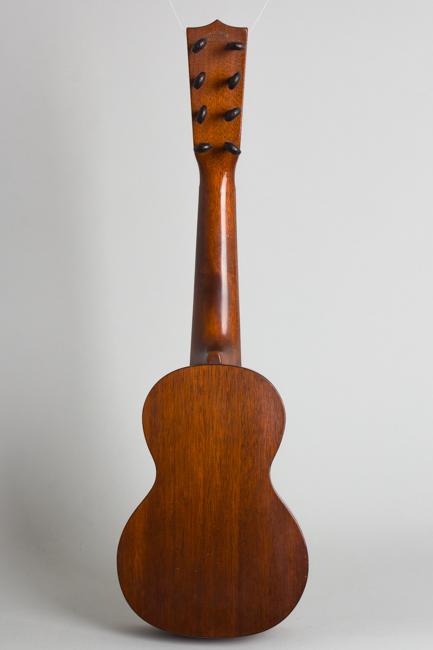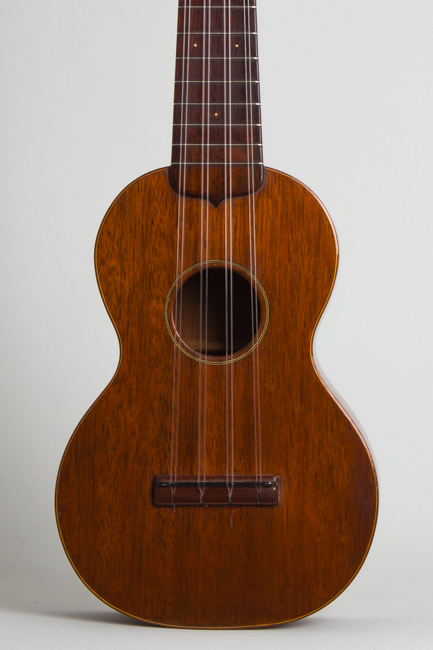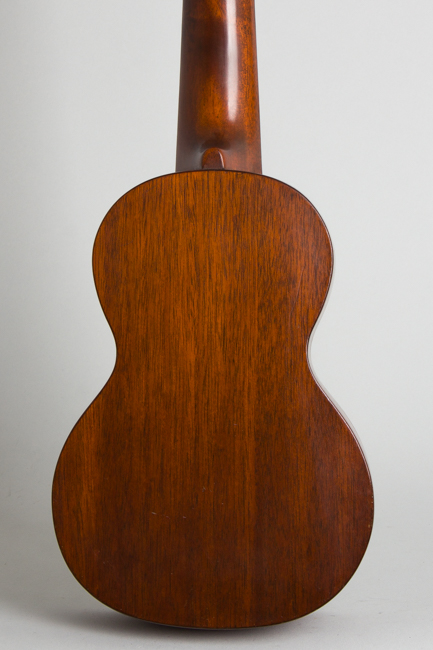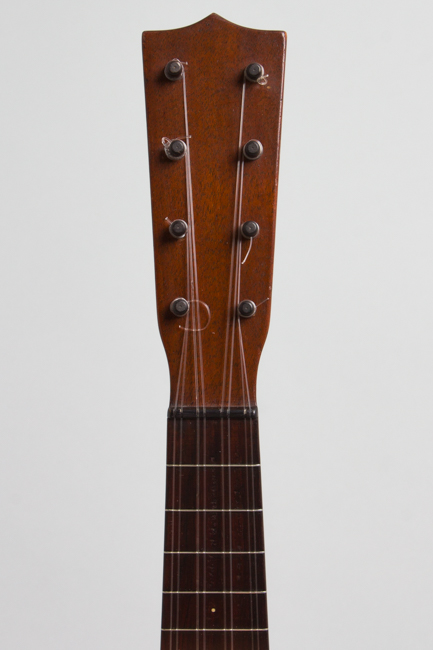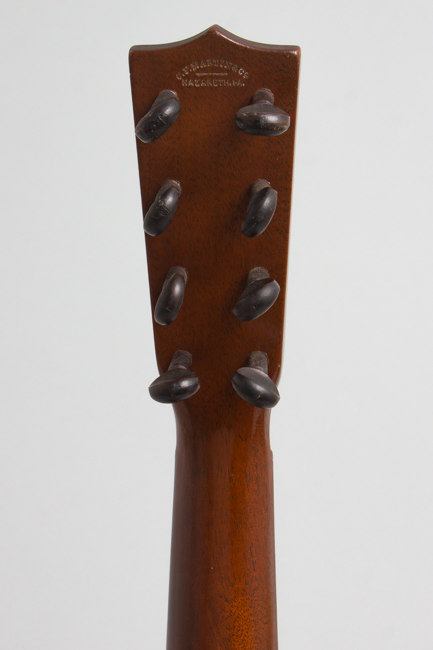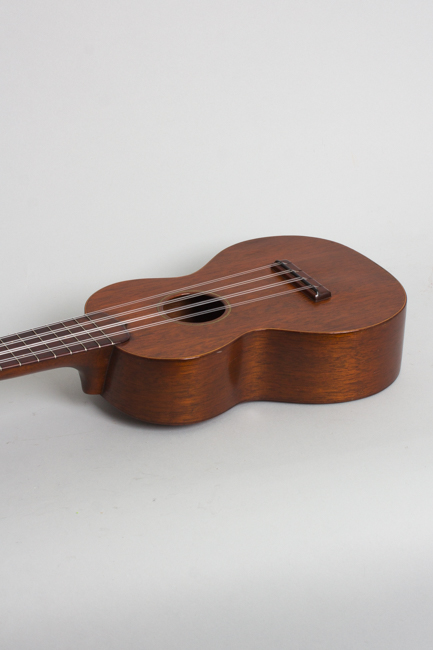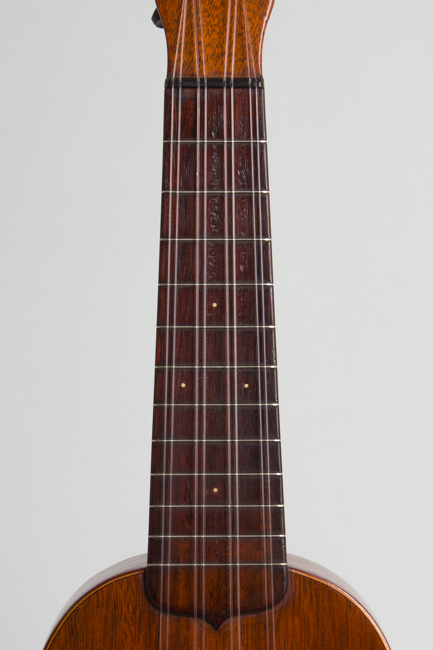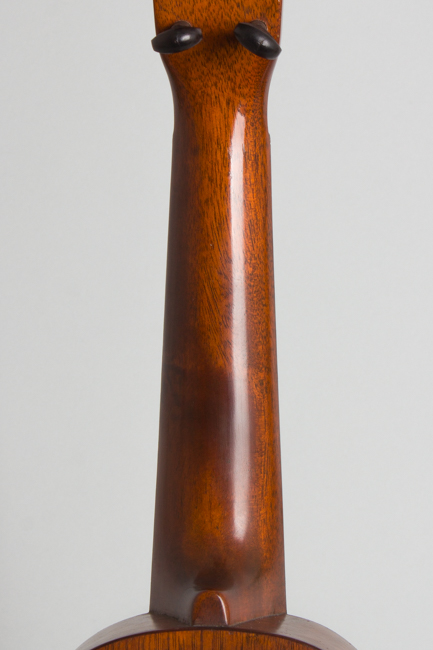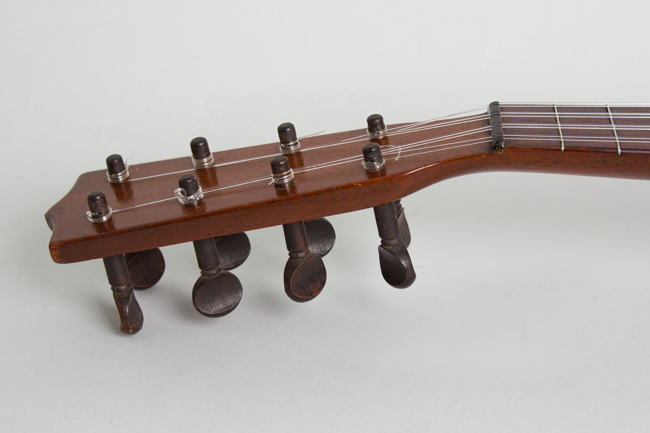C. F. Martin Style 1 Taropatch (1926)
C. F. Martin Style 1 Model Taropatch (1926), Nazareth, PA.
The eight-string Taropatch (originally called the "Taro Patch fiddle") was one of the early Hawaiian forms of the ukulele, persisting in the islands even after the familiar 4-string uke was popularized. Comparatively few versions were ever made on the mainland, but the instrument was offered as part of C. F. Martin's early ukulele line from 1916 through 1931. With eight gut strings on a longer scale neck the Taropatch was considered harder to play (and tune!) than the simple uke, and thus ordered in vastly smaller numbers. Eventually Martin adapted this body form into the 4-string concert uke, which pretty much replaced it in the company's line.
Style 1 was Martin's baseline level for uke family instruments; pro-quality, but not out-and-out flashy. This Style 1 Taropatch sports a very thin dark natural mahogany finish offset with 3-ply wood celluloid binding around the top and a single ply on the back, a feature added in 1926. There is a discreet wooden sound hole ring ornament and 4 tiny position dots on the fingerboard; the nut and saddle are ebony.
The Martin Taropatch was offered as a stock model in mahogany in Styles 1, 2 and 3 and also in Koa at a slight upcharge. Even this basic model 1920s Style 1 is a fairly rare instrument, one of aroud 1100 ever made. Style 1 Taropatches were listed in the catalog until 1931 but few were actually built after 1927; the combination of wooden pegs and beck binding neatly dates this one to 1926, the next-to-last year when 177 were shipped. This is a lovely find and a fine playing instrument; while more awkward to tune than a 4-string uke it rewards the player with a distinctive chorused double-strung sound that has a real archaic island character.
Overall length is 25 1/8 in. (63.8 cm.), 7 5/8 in. (19.4 cm.) wide at lower bout, and 2 3/4 in. (7 cm.) in depth at side, taken at the end block. Scale length is 14 3/4 in. (375 mm.). Width of nut is 1 1/2 in. (38 mm.).
This century old Taropatch survives in original and excellent playing condition. The very thin varnish finish has just minor wear with dings, dents and scuffs. With many Taropatches the recesses in the bridge holding the doubled strings show wear and re-working, on this instrument they are undisturbed; there are a few marks behind the bridge from re-stringing.
There are a couple of odd grain anomalies to the wood used for the neck, a mark at the lower end of the heel looks almost like a crack but is actually under the undisturbed original finish. The fingerboard has some odd grain striations as well; it appears at the height of the ukulele boom Martin was rushing these out as fast as they could.
None of this affects function at all and the instrument plays very nicely and holds tune as well as these ever do, a very nice example of a rare and beautiful early Martin ukulele family instrument that seldom turns up today. It resides in a modern gig bag. Excellent - Condition.
The eight-string Taropatch (originally called the "Taro Patch fiddle") was one of the early Hawaiian forms of the ukulele, persisting in the islands even after the familiar 4-string uke was popularized. Comparatively few versions were ever made on the mainland, but the instrument was offered as part of C. F. Martin's early ukulele line from 1916 through 1931. With eight gut strings on a longer scale neck the Taropatch was considered harder to play (and tune!) than the simple uke, and thus ordered in vastly smaller numbers. Eventually Martin adapted this body form into the 4-string concert uke, which pretty much replaced it in the company's line.
Style 1 was Martin's baseline level for uke family instruments; pro-quality, but not out-and-out flashy. This Style 1 Taropatch sports a very thin dark natural mahogany finish offset with 3-ply wood celluloid binding around the top and a single ply on the back, a feature added in 1926. There is a discreet wooden sound hole ring ornament and 4 tiny position dots on the fingerboard; the nut and saddle are ebony.
The Martin Taropatch was offered as a stock model in mahogany in Styles 1, 2 and 3 and also in Koa at a slight upcharge. Even this basic model 1920s Style 1 is a fairly rare instrument, one of aroud 1100 ever made. Style 1 Taropatches were listed in the catalog until 1931 but few were actually built after 1927; the combination of wooden pegs and beck binding neatly dates this one to 1926, the next-to-last year when 177 were shipped. This is a lovely find and a fine playing instrument; while more awkward to tune than a 4-string uke it rewards the player with a distinctive chorused double-strung sound that has a real archaic island character.
Overall length is 25 1/8 in. (63.8 cm.), 7 5/8 in. (19.4 cm.) wide at lower bout, and 2 3/4 in. (7 cm.) in depth at side, taken at the end block. Scale length is 14 3/4 in. (375 mm.). Width of nut is 1 1/2 in. (38 mm.).
This century old Taropatch survives in original and excellent playing condition. The very thin varnish finish has just minor wear with dings, dents and scuffs. With many Taropatches the recesses in the bridge holding the doubled strings show wear and re-working, on this instrument they are undisturbed; there are a few marks behind the bridge from re-stringing.
There are a couple of odd grain anomalies to the wood used for the neck, a mark at the lower end of the heel looks almost like a crack but is actually under the undisturbed original finish. The fingerboard has some odd grain striations as well; it appears at the height of the ukulele boom Martin was rushing these out as fast as they could.
None of this affects function at all and the instrument plays very nicely and holds tune as well as these ever do, a very nice example of a rare and beautiful early Martin ukulele family instrument that seldom turns up today. It resides in a modern gig bag. Excellent - Condition.
